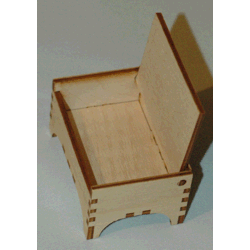 We cut for you,
We cut for you,'cause that's what we do
 We cut for you,
We cut for you,'cause that's what we do |
|
|
Laser Cutting How to use our Laser Cutting Service Samples Contact Us |
Laser Cutting InformationHow to | Materials | Limitations | Request quote | Pricing | Home How toThe process starts with a drawing of your part(s) in a file format that the laser can understand. Usable formats include .dxf, .cdr, .ai, and many other vector file formats. If in doubt most drawing programs allow you to save as / export .dxf format files. If you do not have a computer drawing of your part you can mail or email a drawing or sketch along with the required sizes and we can draw it for you. Once you have a design you can email it to us and we will send you an estimate of the costs. Upon receiving your approval and payment in full we will cut and ship your part to you. Tips for Preparing Files for laser cutting If you create your design using a program such as CorelDRAW, Adobe Illustrator, AutoCad, or TurboCAD, here are some tips for designing your parts;
For parts that have a critical fit you may want to adjust your drawing for the kerf, the width of the cut made by the laser, which is about 0.005". The preferred method of doing this is to draw your part to the required size and then save both the original drawing and a cutting path copy. Edit the cutting path copy by creating an offset of .0025" to the outside of parts (or to the inside of holes) and then deleting the original lines. Note that the absolute accuracy of the part may vary slightly depending on the material and its thickness. The largest part we can cut is 24" X 39". If the part doesn't fit in an 24" X 39" box in your drawing program it will not fit in the laser either! Text, thick lines, bit maps, and fills (shaded areas) will be not be cut but may be engraved if that is required. Note that if a black graphic has a thin red outline the laser will engrave the area and then cut along the outline. MaterialsWe can laser cut;
We can supply Baltic Birch plywood, Lexan, and acrylic, and can quickly obtain most other sheet plastic materials from our suppliers (minimum quantities may apply). If you wish you can also ship your materials to us or have them drop shipped to us from your supplier. To determine if your material is suitable for this process please send a small piece of your material (4" X 4") and return postage and we will make a sample for you. LimitationsThe largest part we can laser cut is 24" X 39". Plastic thickness is nominal and can vary by + or -10%. The laser cuts at a slight taper. Due to the taper, one side of a laser-cut part (the side that the beam hits first) will have a slightly wider kerf (cut width) than the opposite side. The taper is almost unnoticeable in 1/8" material and more noticeable on thicker material. Note that this is not the case for Acrylic, which cuts with a vertical edge up to 1/2" thick. The kerf (the thickness of the laser beam) is about 0.005". See tips above to learn how to adjust for the kerf. The edges of some materials including Lexan, wood, and paper may be discoloured by smoke or charring. The thicker the material the more discolouration there will be. The accuracy of the cut will be +/- .002". Requesting a QuoteOnce you have your drawing finished, you can send it along with an email to request a quote from us. Some of the things to include in the email would be:
Pricing$30.00 minimum/jobNo set-up fee. Drawing is $60 / hour with a 1/2 hour minimum. $4.00 per minute of laser time, billed to the nearest 0.1 minute. For larger jobs (order totalling over 2 hours) we offer a lower per minute cost. Orders paid by Interac eTransfer, PayPal, money order, bank draft, or certified cheque will be added to the production schedule immediately. Orders paid by personal cheque will be held until the cheque clears and will then be added to the production schedule. No order will be processed before receiving payment in full. Most jobs are shipped within 5 business days of receiving payment. Rush orders (24 - 48 hours from payment to shipping) can be accommodated for most orders (subject to a usable drawing being supplied, the availability of materials, and the size of the job) but there is a 100% surcharge for this service with a $100.00 minimum. Shipping costs start at only $0.90, and we do not charge a handling
fee. Hit Counters |

Please Click here for more sample pictures of our laser cutting process |